Material Parameters Identification of Historic Lighthouse Based on Operational Modal Analysis
Abstract
1. Introduction
2. Materials and Methods
2.1. The Lighthouse
2.1.1. Description of the Structure
2.1.2. Dynamic Measurements
2.2. Modal Identification Techniques
2.2.1. Peak Picking Method Based on the Correlation Analysis (PP-CA)
2.2.2. Eigensystem Realization Algorithm (ERA)
2.2.3. Natural Excitation Technique and ERA (NExT-ERA)
2.3. Numerical Model of the Lighthouse
3. Results
3.1. Modal Identification
3.2. FEM Model Validation
4. Discussion
5. Conclusions
Author Contributions
Funding
Acknowledgments
Conflicts of Interest
References
- Rainieri, C.; Fabbrocino, G. Operational Modal Analysis of Civil Engineering Structures; Springer: New York, NY, USA, 2014. [Google Scholar]
- Brincker, R.; Ventura, C. Introduction to Operational Modal Analysis; John Wiley & Sons: Hoboken, NJ, USA, 2015. [Google Scholar]
- Brownjohn, J.M.W.; Raby, A.; Bassitt, J.; Antonini, A.; Hudson, E.; Dobson, P. Experimental modal analysis of British rock lighthouses. Mar. Struct. 2018, 62, 1–22. [Google Scholar] [CrossRef]
- Ivorra, S.; Pallarés, F.J. Dynamic investigations on a masonry bell tower. Eng. Struct. 2006, 28, 660–667. [Google Scholar] [CrossRef]
- Diaferio, M.; Foti, D.; Giannoccaro, N.I.; Ivorra, S. Model updating based on the dynamic identification of a baroque bell tower. Int. J. Saf. Secur. Eng. 2017, 7, 519–531. [Google Scholar] [CrossRef]
- Ubertini, F.; Comanducci, G.; Cavalagli, N. Vibration-based structural health monitoring of a historic bell-tower using output-only measurements and multivariate statistical analysis. Struct. Heal. Monit. 2016, 15, 438–457. [Google Scholar] [CrossRef]
- Azzara, R.M.; Girardi, M.; Iafolla, V.; Lucchesi, D.M.; Padovani, C.; Pellegrini, D. Ambient Vibrations of Age-old Masonry Towers: Results of Long-term Dynamic Monitoring in the Historic Centre of Lucca. Int. J. Archit. Herit. 2019, 1–17. [Google Scholar] [CrossRef]
- Tomaszewska, A.; Szymczak, C. Identification of the Vistula Mounting tower model using measured modal data. Eng. Struct. 2012, 42, 342–348. [Google Scholar] [CrossRef]
- Bendat, J.; Piersol, A. Engineering Applications of Correlation and Spectral Analysis; John Wiley & Sons: Hoboken, NJ, USA, 1980. [Google Scholar]
- Tomaszewska, A. Influence of statistical errors on damage detection based on structural flexibility and mode shape curvature. Comput. Struct. 2010, 88, 154–164. [Google Scholar] [CrossRef]
- Tomaszewska, A.; Szafranski, M. Study on applicability of two modal identification techniques in irrelevant cases. Arch. Civ. Mech. Eng. 2020, 20, 1–11. [Google Scholar] [CrossRef]
- Brownjohn, J.M.W. Ambient vibration studies for system identification of tall buildings. Earthq. Eng. Struct. Dyn. 2003, 32, 71–95. [Google Scholar] [CrossRef]
- Chen, G.; Omenzetter, P.; Beskhyroun, S. Operational modal analysis of an eleven-span concrete bridge subjected to weak ambient excitations. Eng. Struct. 2017, 151, 839–860. [Google Scholar] [CrossRef]
- Maia, N.M.M.; Montalvao Silva, J.M.M. Theoretical and Experimental Modal Analysis, 1st ed.; Research Studies Press Ltd.: Baldock, UK, 1998. [Google Scholar]
- Juang, J.-N.; Pappa, R.S. An eigensystem realization algorithm for modal parameter identification and model reduction. J. Guid. Control Dyn. 1985, 8, 620–627. [Google Scholar] [CrossRef]
- Juang, J.-N. Applied System Identification; Prentice-Hall PTR: Englewood Clifs, NJ, USA, 1994. [Google Scholar]
- Rusinski, E.; Dragan, S.; Moczko, P.; Pietrusiak, D. Implementation of experimental method of determining modal characteristics of surface mining machinery in the modernization of the excavating unit. Arch. Civ. Mech. Eng. 2012, 12, 471–476. [Google Scholar] [CrossRef]
- Szafranski, M. Dynamics of the small-span railway bridge under moving loads. MATEC Web. Conf. 2019, 262, 1–8. [Google Scholar] [CrossRef]
- Szafrański, M. A dynamic vehicle-bridge model based on the modal identification results of an existing EN57 train and bridge spans with non-ballasted tracks. Mech. Syst. Signal Pr. 2021, 146, 107039–107056. [Google Scholar] [CrossRef]
- Bernagozzi, G.; Mukhopadhyay, S.; Betti, R.; Landi, L.; Diotallevi, P.P. Output-only damage detection in buildings using proportional modal flexibility-based deflections in unknown mass scenarios. Eng. Struct. 2018, 167, 549–566. [Google Scholar] [CrossRef]
- Binczyk, M.; Kalitowski, P.; Szulwic, J.; Tysiac, P. Nondestructive testing of the miter gates using various measurement methods. Sensors (Switzerland) 2020, 20, 1749. [Google Scholar] [CrossRef]
- James, G.; Carne, T.; Lauffer, J. The natural excitation technique (NExT) for modal parameter extraction from operating structures. Modal Anal. Int. J. Anal. Exp. Modal Anal. 1995, 10, 260. [Google Scholar]
- Siringoringo, D.M.; Fujino, Y. System identification of suspension bridge from ambient vibration response. Eng. Struct. 2008, 30, 462–477. [Google Scholar] [CrossRef]
- Nayeri, R.D.; Tasbihgoo, F.; Wahbeh, M.; Caffrey, J.P.; Masri, S.F.; Conte, J.P.; Elgamal, A. Study of time-domain techniques for modal parameter identification of a long suspension bridge with dense sensor arrays. J. Eng. Mech. 2009, 135, 669–683. [Google Scholar] [CrossRef]
- Caicedo, J.M. Practical guidelines for the natural excitation technique (NExT) and the eigensystem realization algorithm (ERA) for modal identification using ambient vibration. Exp. Tech. 2011, 35, 52–58. [Google Scholar] [CrossRef]
- Hosseini Kordkheili, S.A.; Momeni Massouleh, S.H.; Hajirezayi, S.; Bahai, H. Experimental identification of closely spaced modes using NExT-ERA. J. Sound Vib. 2018, 412, 116–129. [Google Scholar] [CrossRef]
- Habbit, D.; Karlsson, B.; Sorensen, P. ABAQUS Analysis User’s Manual; Hibbit, Karlsson, Sorensen Inc.: Providence, RI, USA, 1997. [Google Scholar]
- Karagianni, A.; Karoutzos, G.; Ktena, S.; Vagenas, N.; Vlachopoulos, I.; Sabatakakis, N.; Koukis, G. Elastic properties of rocks. Bull. Geol. Soc. Greece 2010, 43, 1539–1548. [Google Scholar] [CrossRef]
- Zanotti Fragonara, L.; Boscato, G.; Ceravolo, R.; Russo, S.; Ientile, S.; Pecorelli, M.L.; Quattrone, A. Dynamic investigation on the Mirandola bell tower in post-earthquake scenarios. Bull Earthq. Eng. 2017, 15, 313–337. [Google Scholar] [CrossRef]
- Bull, J.W. Computational Modelling of Masonry, Brickwork and Blockwork Structures; Saxe-Coburg Publications: Stirling, UK, 2001. [Google Scholar]
- Russo, G.; Bergamo, O.; Damiani, L.; Lugato, D. Experimental analysis of the “Saint Andrea” Masonry Bell Tower in Venice. A new method for the determination of “Tower Global Young’s Modulus E”. Eng. Struct. 2010, 32, 353–360. [Google Scholar] [CrossRef]
- Gentile, C.; Saisi, A. Ambient vibration testing of historic masonry towers for structural identification and damage assessment. Constr. Build. Mater. 2007, 21, 1311–1321. [Google Scholar] [CrossRef]
- Smoljanović, H.; Nikolić, Ž.; Živaljić, N. A finite-discrete element model for dry stone masonry structures strengthened with steel clamps and bolts. Eng. Struct. 2015, 90, 117–129. [Google Scholar] [CrossRef]
- Arêde, A.; Almeida, C.; Costa, C.; Costa, A. In-situ and lab tests for mechanical characterization of stone masonry historical structures. Constr. Build. Mater. 2019, 220, 503–515. [Google Scholar] [CrossRef]
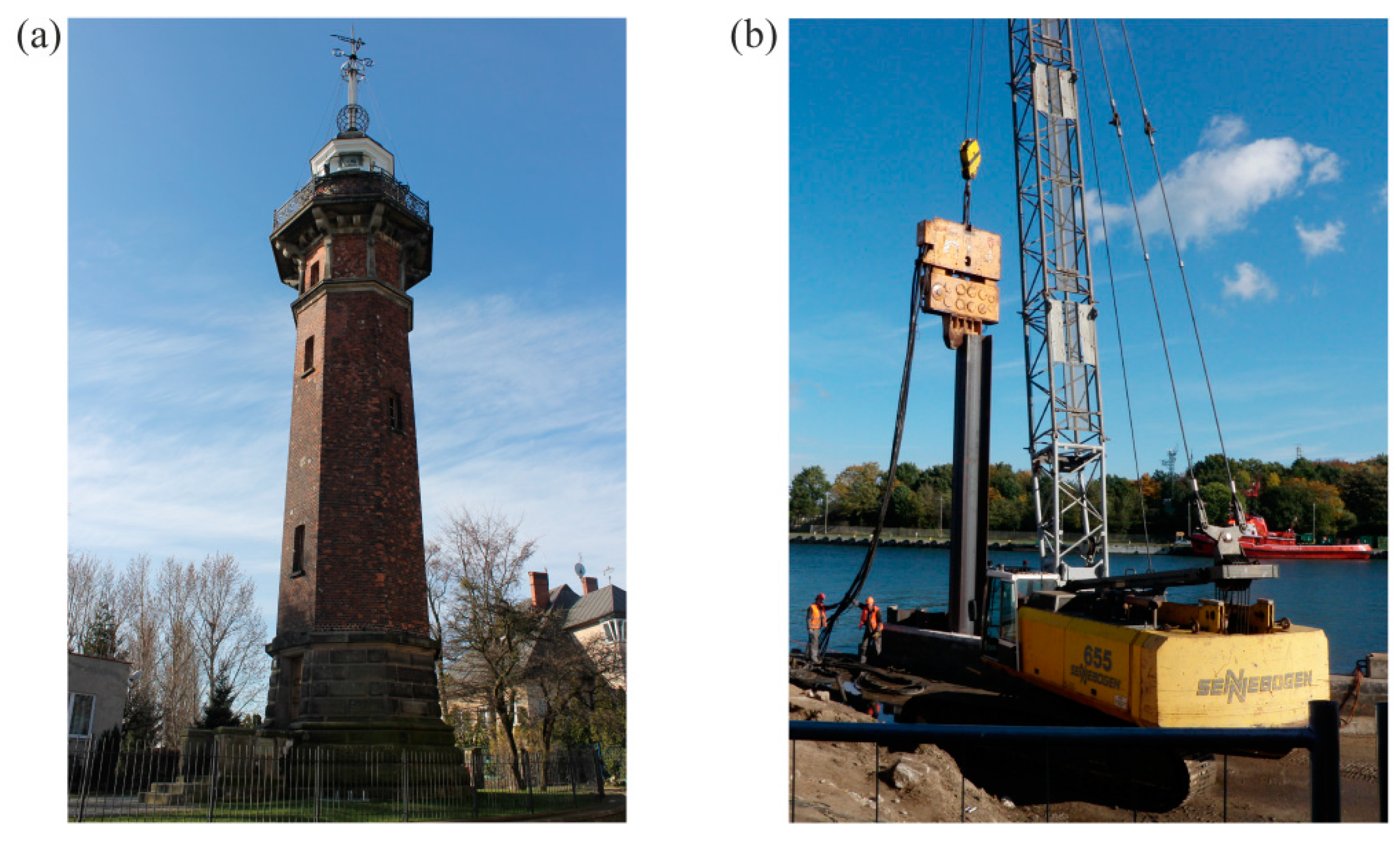

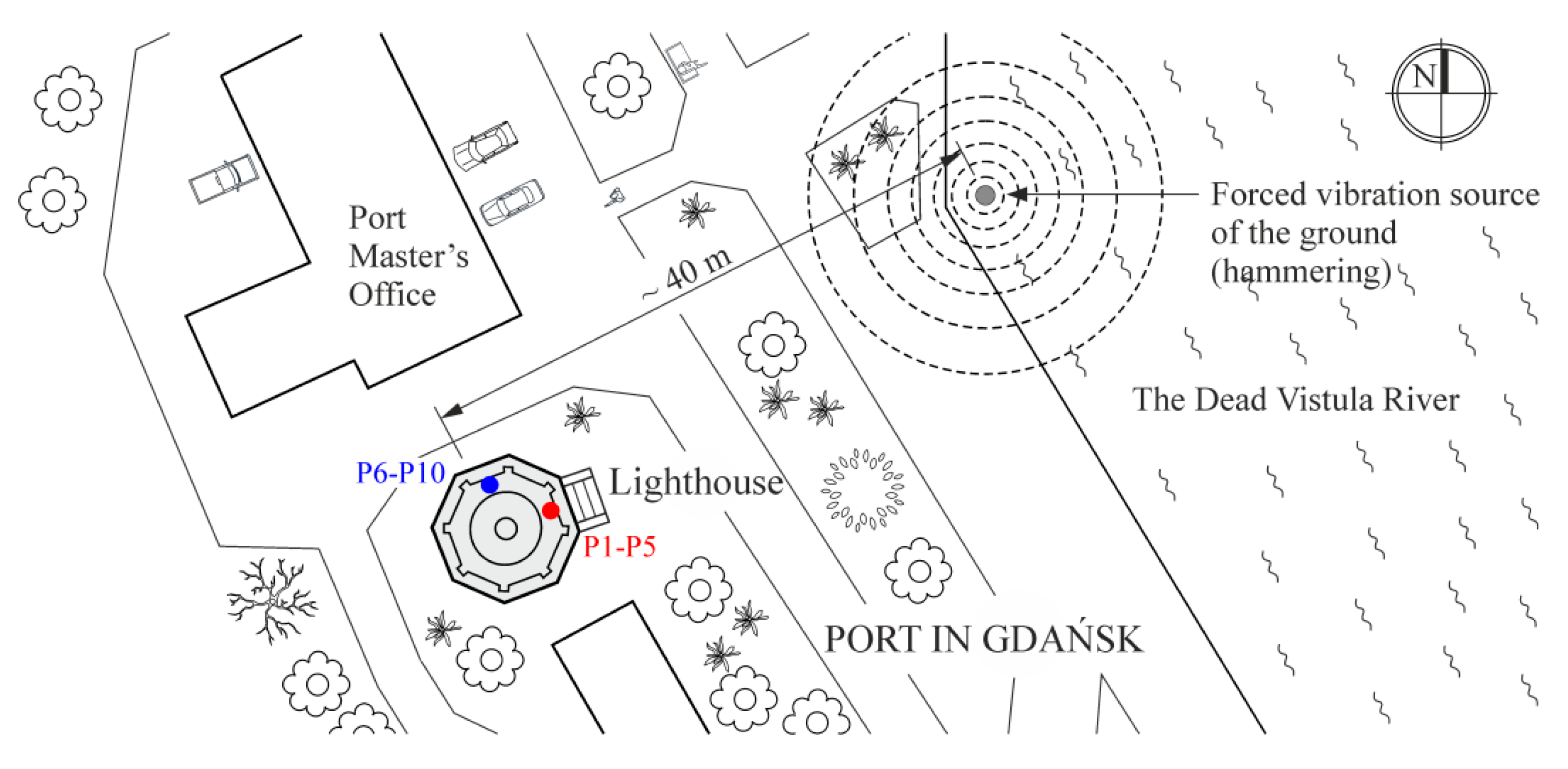


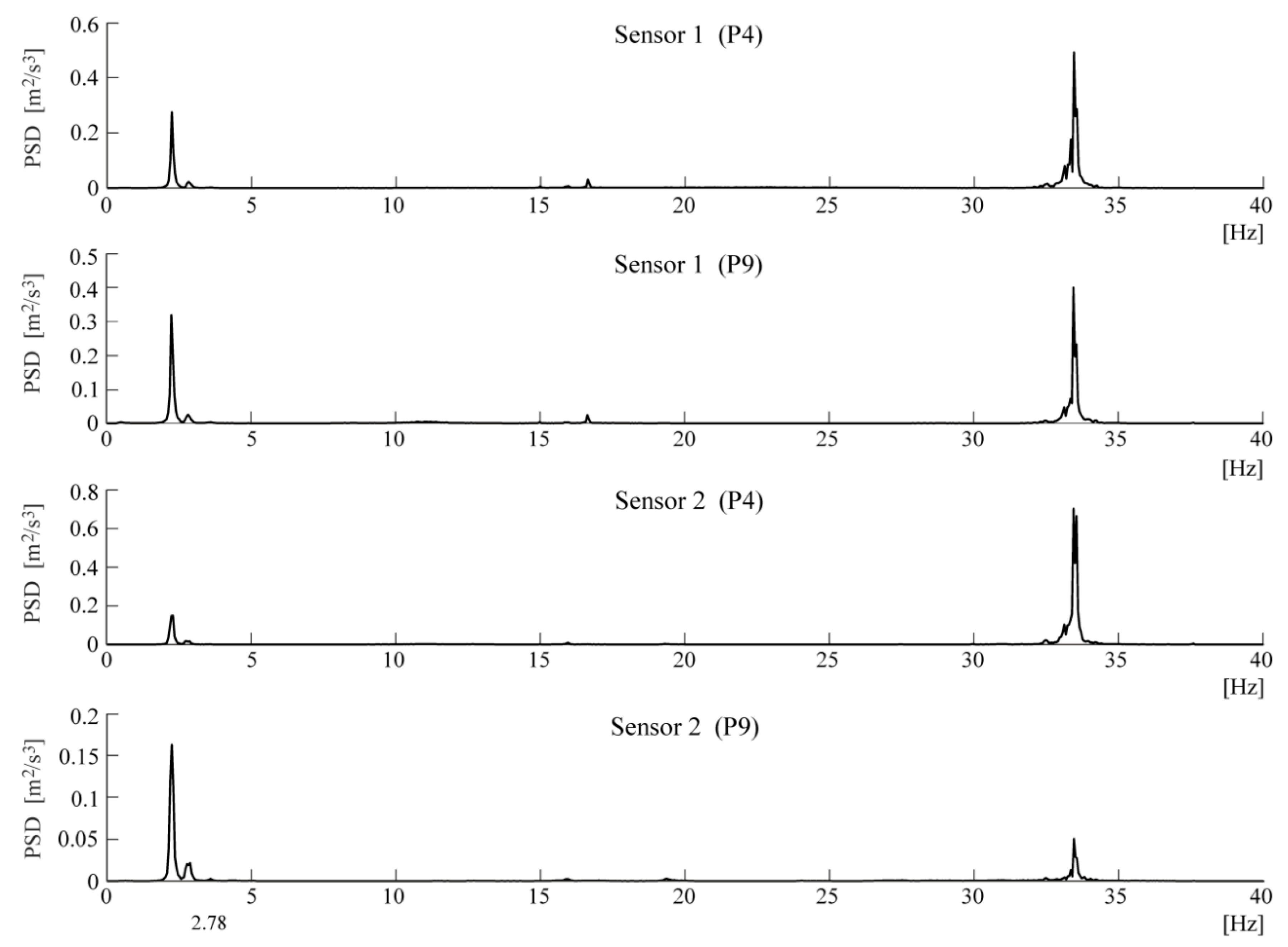

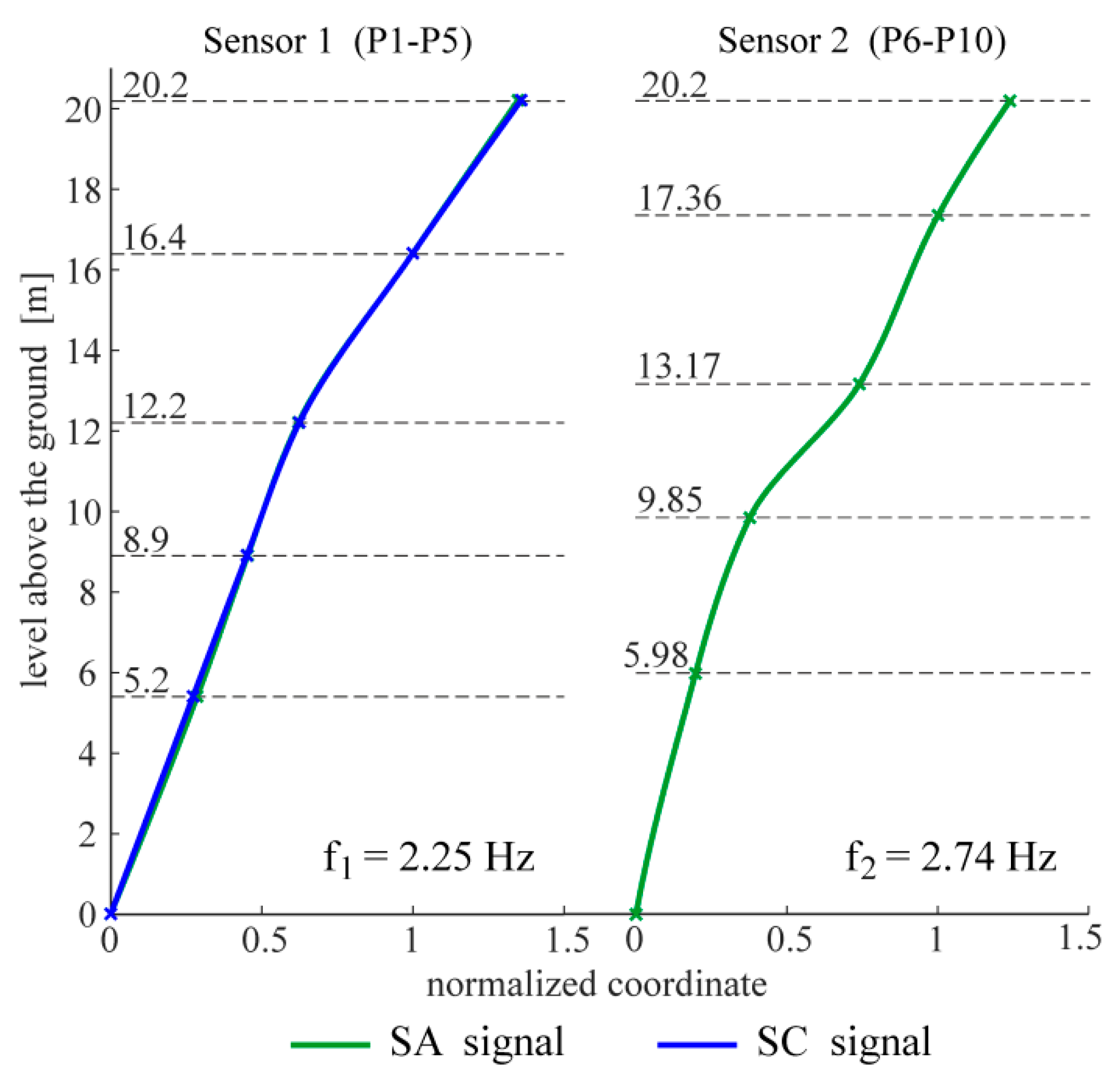
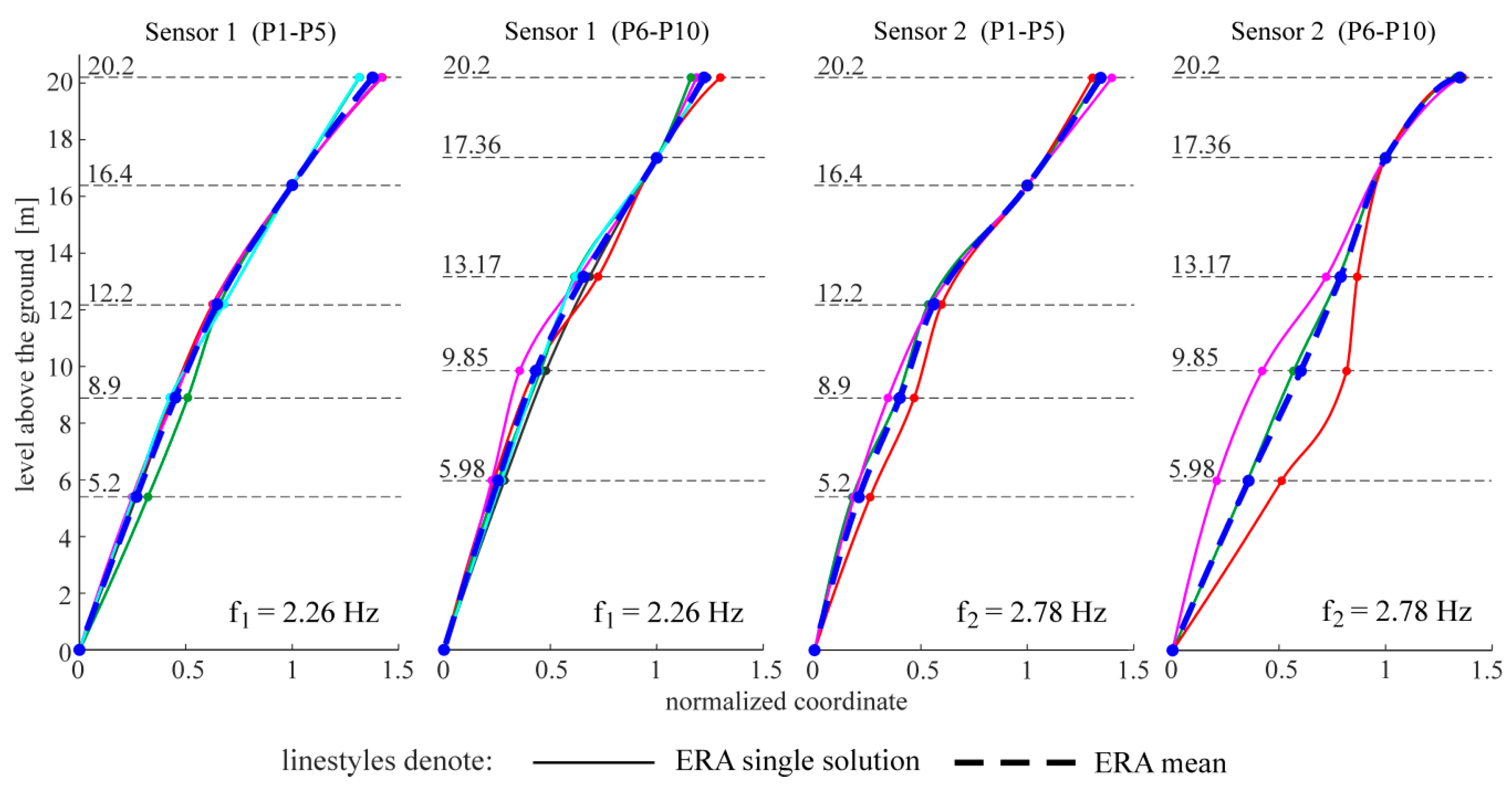
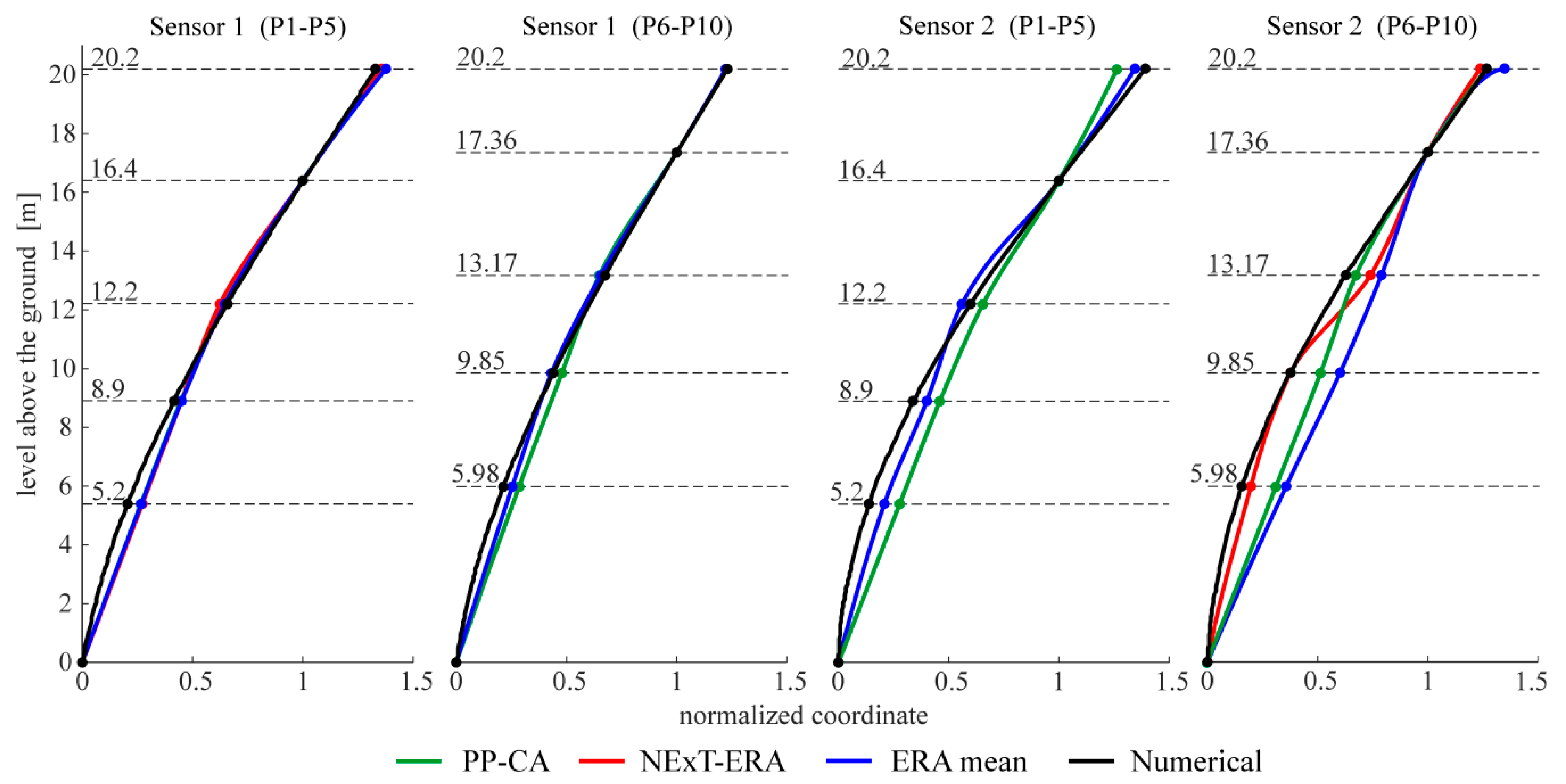
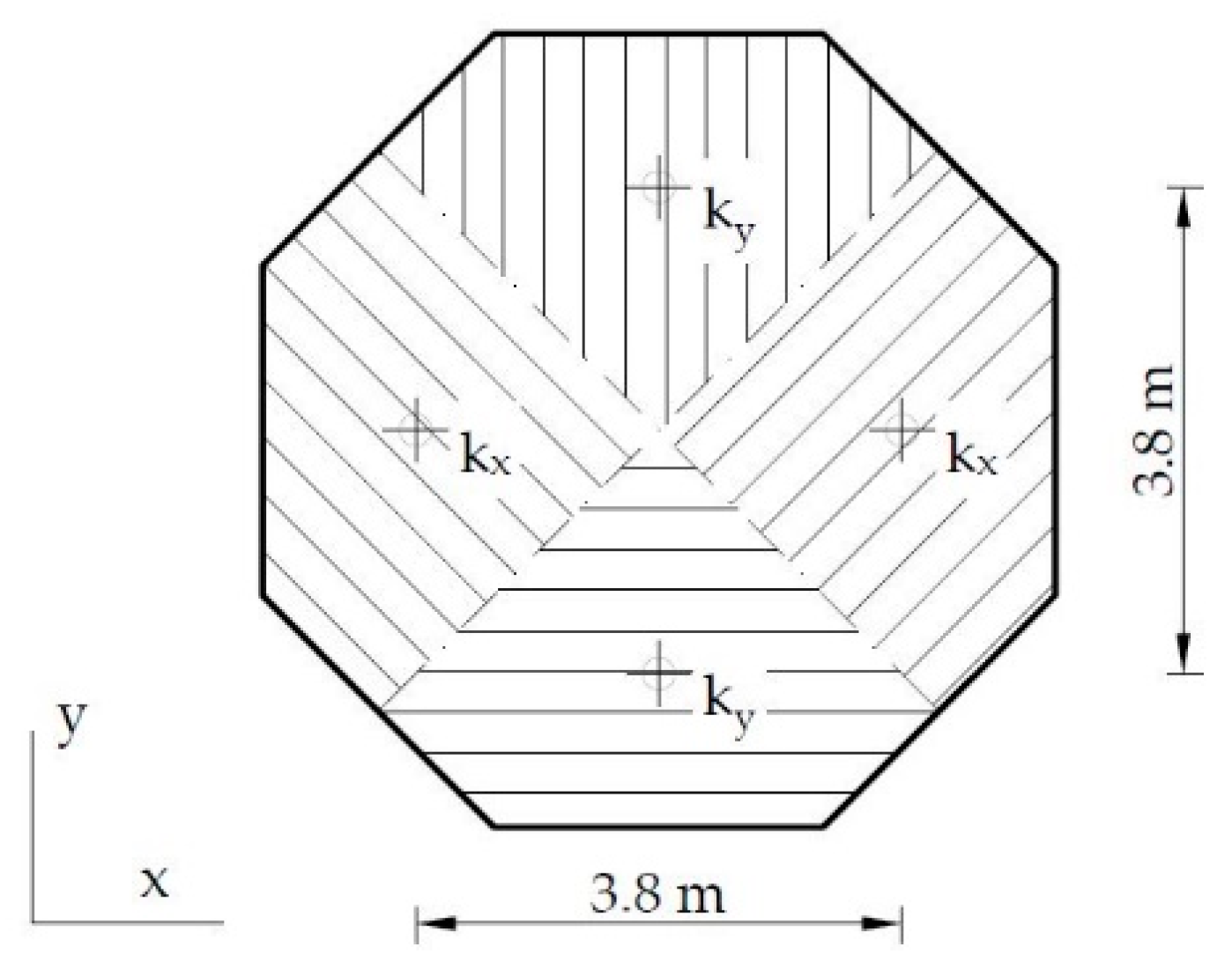
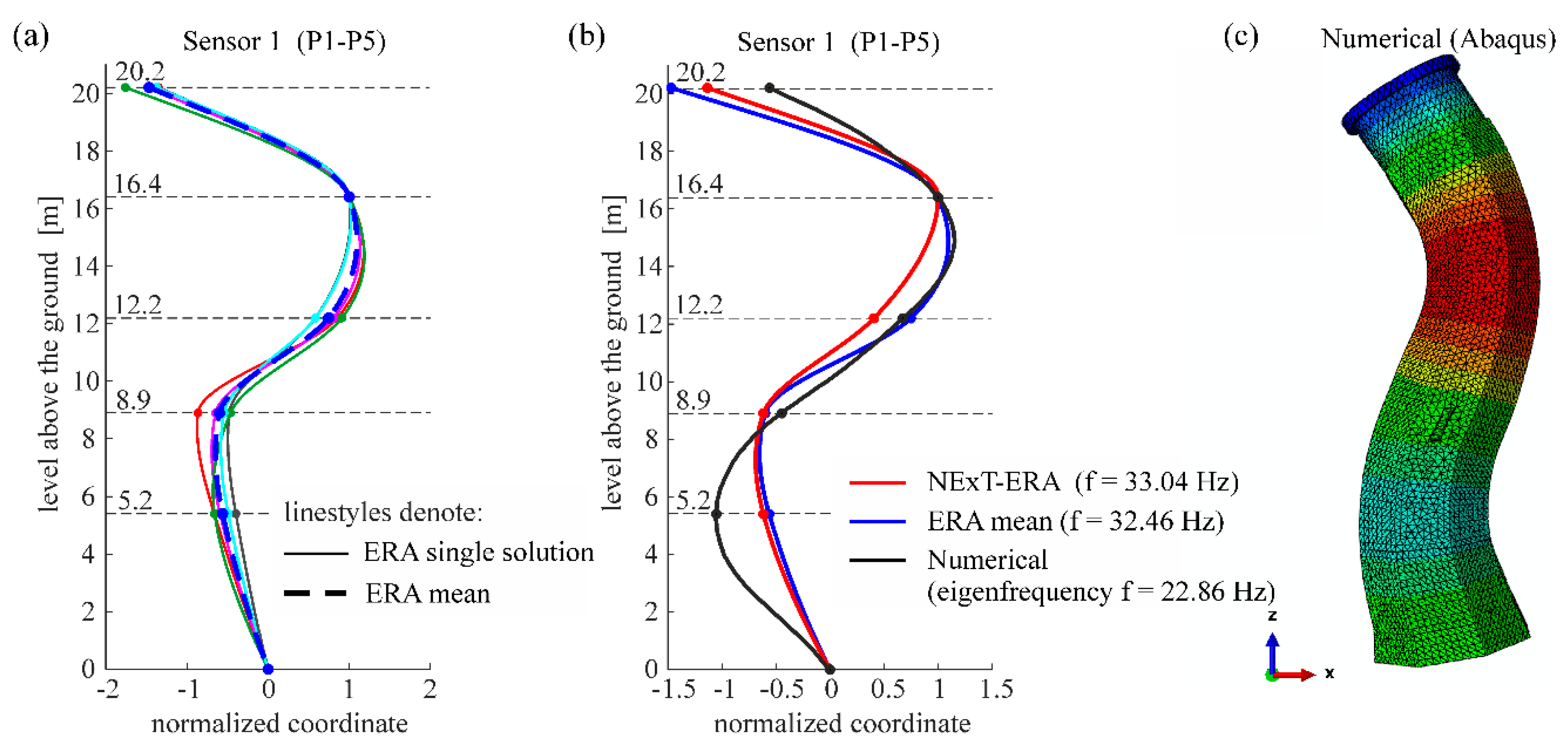
| Method | Natural Frequency—First Mode (Hz) | Natural Frequency—Second Mode (Hz) | Damping Coefficient |
|---|---|---|---|
| Peak Picking | 2.24 | 2.80 | - |
| NExT-ERA | 2.25 | 2.74 | 0.0226 |
| ERA | 2.26 | 2.78 | 0.0244 |
| Numerical | 2.23 | 2.81 | - |
| Material | Initial Elastic Modulus (GPa) | Final Elastic Modulus (GPa) | Poisson’s Ratio | Initial Density (kg/m3) | Final Density (kg/m3) |
|---|---|---|---|---|---|
| Brick masonry | 1 | 2.4 | 0.167 | 2200 | 2100 |
| Sandstone | 10 | 2.4 | 0.2 | 2400 | 2100 |
| Granite | 80 | 26 | 0.3 | 2600 | 2000 |
© 2020 by the authors. Licensee MDPI, Basel, Switzerland. This article is an open access article distributed under the terms and conditions of the Creative Commons Attribution (CC BY) license (http://creativecommons.org/licenses/by/4.0/).
Share and Cite
Tomaszewska, A.; Drozdowska, M.; Szafrański, M. Material Parameters Identification of Historic Lighthouse Based on Operational Modal Analysis. Materials 2020, 13, 3814. https://doi.org/10.3390/ma13173814
Tomaszewska A, Drozdowska M, Szafrański M. Material Parameters Identification of Historic Lighthouse Based on Operational Modal Analysis. Materials. 2020; 13(17):3814. https://doi.org/10.3390/ma13173814
Chicago/Turabian StyleTomaszewska, Agnieszka, Milena Drozdowska, and Marek Szafrański. 2020. "Material Parameters Identification of Historic Lighthouse Based on Operational Modal Analysis" Materials 13, no. 17: 3814. https://doi.org/10.3390/ma13173814
APA StyleTomaszewska, A., Drozdowska, M., & Szafrański, M. (2020). Material Parameters Identification of Historic Lighthouse Based on Operational Modal Analysis. Materials, 13(17), 3814. https://doi.org/10.3390/ma13173814






